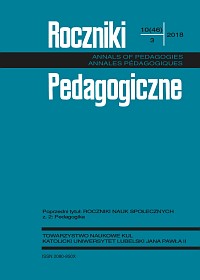The Relationship Between the Level of Development of Pretend Play and Severity of ASD Symptoms in Pre-School and Younger School Aged Children
Main Article Content
Abstract
Pretending in play is the foundation for the further development of a young child, and the deficit in the development of this skill results in his difficulties in making peer relationships. Such a difficulty is a key characteristic of the functioning of children with autism spectrum disorders (ASD). Researchers also notice a significantly reduced level of development of the ability to pretend in play and its relationship with the severity of autism symptoms. However, there is a lack of precise description in the literature of which autism symptoms this relationship applies to.
In order to establish the relationships between: the level of development of the ability to pretend play and the autism syndrome severity, there was conducted studies in a group of 38 children with ASD, between 4.0 and 9.3 years of age. The following tools were used: Autism Syndrome Severity Scale (Krzysztofik, Otrębski, 2016) and the Pretend play – third part of SToMM (Krzysztofik, 2016).
Obtained results indicating the existence of relationships between the level of development of the ability to pretend play and the severity of autism syndrome (especially deficits in social interactions and communication), have some implications for the rehabilitation of people with ASD.
Article Details
References
Baird, G., Simonoff, E., Pickles, A., Chandler, S., Loucas, T., Meldrum, D., Charman, T. (2006). Prevalence of disorders of the autism spectrum in a population cohort of children in South Thames: the Special Needs and Autism Project (SNAP). Lancet, 368 (9531), 210-215.
Baron-Cohen, S. (1987). Autism and symbolic play. British Journal of Developmental Psychology, 5 (2), 139-148.
Baron-Cohen, S. (1995). Mindblindness: An Essay on Autism and Theory of Mind. Cambridge: The MIT Press.
Chan, P., Chen, C., Feng, H., Lee, Y., Chen, K. (2016). Theory of Mind Deficit Is Associated with Pretend Play Performance, but Not Playfulness, in Children with Autism Spectrum Disorder. Hong Kong Journal of Occupational Therapy, 28, 43-52.
Fein, G.G. (1981). Pretend play in childhood: An integrative review. Child Development, 52, 1095-1118.
Frith, U. (2008). Autyzm. Wyjaśnienie tajemnicy (przekł. M. Hernik, G. Krajewski). Gdańsk: GWP.
Gopnik, A. (2010). Dziecko filozofem. Co dziecięce umysły mówią nam o prawdzie, miłości oraz sensie życia (przekł. M. Trzcińska). Warszawa: Prószyński i S-ka.
Hadwin, J., Baron-Cohen, S., Howlin, P., Hill, K. (1996). Can we teach children with autism to understand emotions, belief and pretence? Development and Psychopatology, 8, 345-365.
Howlin, P., Baron-Cohen, S., Hadwin, J. (1999). Teaching children with autism to mind-read: a practical guide. Chichester, West Sussex: John Wiley and Sons.
Kang, E., Klein, E.F., Lillard, A.S., Lerner, M.D. (2016). Predictors and Moderators of Spontaneous Pretend Play in Children with and without Autism Spectrum Disorder. Frontiers in Psychology, 7.
Krzysztofik, K. (2016). Skala Mechanizmu Teorii Umysłu (SToMM). Lublin: KPReh KUL.
Krzysztofik, K., Otrębski, W. (2016). Skala Nasilenia Syndromu Autyzmu – Rewitalizacja. Lublin: KPReh KUL.
Lang, R., Machalicek, W., Rispolic, M., O’Reilly, M., Sigafoose, J., Lancioni, G., Peters-Scheffer, N., Diddeng, R. (2014). Play skills taught via behavioral intervention generalize, maintain, and persist in the absence of socially mediated reinforcement in children with autism. Research in Autism Spectrum Disorders, 8, 860-872.
Lee, Y., Chan, P., Lin, S., Chen, C., Huang, C., Chen, K. (2016). Correlation patterns between pretend play and playfulness in children with autism spectrum disorder, developmental delay, and typical development. Research in Autism Spectrum Disorders, 24, 29-38.
Leslie, A.M. (1987). Pretense and representation: the origin of “the theory of mind”. Psychological Review, 4, 412-426.
Piaget, J. (1962). Play, dreams and imitation. New York. Wydawnictwo Norton.
Szulman, A. (1996). Skala Nasilenia Syndromu Autyzmu. Lublin: KPReh KUL.
Ungerer, J.A., Sigman, M. (1981). Symbolic Play and Language Comprehension in Autistic Children. Journal of the American Academy of Child Psychiatry, 20, 318-337.
